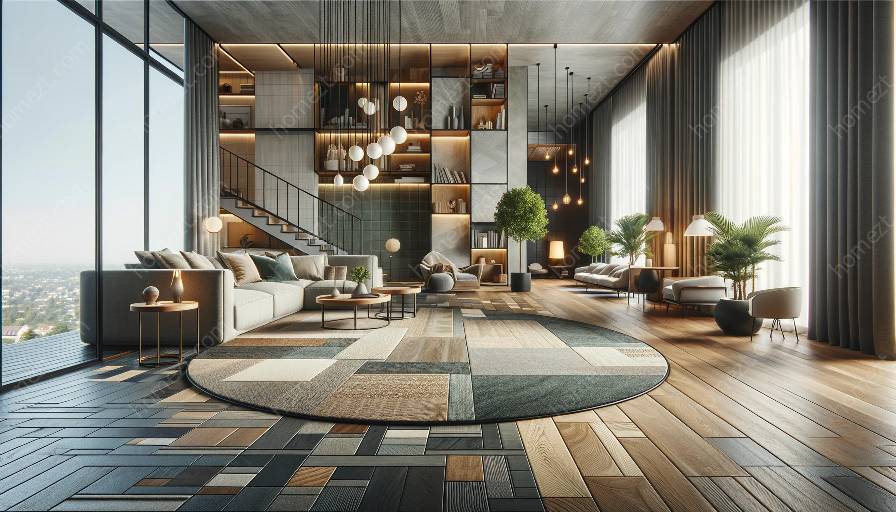Creating a cohesive design with different flooring materials is a key aspect of interior design that can significantly impact the overall aesthetic and functionality of a space. When it comes to choosing flooring materials, there are numerous options available, including hardwood, laminate, tile, carpet, and more. Each material offers unique characteristics and visual appeal, and combining them strategically can elevate the design of your home.
Understanding the Importance of Cohesive Design
Cohesive design refers to the seamless integration of various design elements in a space to create a unified and harmonious look. When it comes to flooring, cohesive design involves selecting materials that complement each other, create visual flow, and contribute to the overall design scheme. By carefully considering the combination of different flooring materials, you can achieve a cohesive and visually appealing design that enhances the ambience of your home.
Exploring Flooring Options
Before delving into the intricacies of creating a cohesive design with different flooring materials, it's essential to understand the available flooring options and their characteristics. Different flooring materials offer distinct visual, tactile, and practical features, making each suitable for specific areas within a home. Some common flooring options include:
- Hardwood: Known for its natural beauty and timeless appeal, hardwood flooring adds elegance and warmth to any space.
- Laminate: Affordable and versatile, laminate flooring comes in various designs that mimic the look of wood, tile, or stone.
- Tile: Durable and moisture-resistant, tile flooring is an excellent choice for kitchens, bathrooms, and other high-traffic areas.
- Carpet: Soft and comfortable underfoot, carpet adds a cozy feel to bedrooms, living rooms, and family rooms.
- Vinyl: Waterproof and low-maintenance, vinyl flooring is available in a wide range of styles, including plank and tile designs.
Creating a Cohesive Look
Combining different flooring materials can introduce visual interest, define functional zones, and enhance the overall design aesthetic. Here are several approaches to creating a cohesive look with various flooring materials:
Open Floor Plan:
For homes with open floor plans, using a single type of flooring throughout the main living areas can create a seamless and unified look. However, if you prefer a bit of variety, consider using area rugs to define specific spaces within the open layout.
Transition Areas:
When transitioning between different flooring materials, such as from hardwood to tile or carpet to laminate, incorporating transition strips can ensure a smooth and visually appealing flow from one area to another.
Complementary Pairings:
Pairing complementary flooring materials, such as hardwood and tile, creates an elegant and distinctive design. For instance, using hardwood in the main living areas and transitioning to tile in the kitchen and bathroom can establish a functional and visually cohesive design.
Mixing Patterns and Textures:
Experimenting with mixing patterns, textures, and colors within the same type of flooring material can add an interesting visual dimension to the design. For example, combining different wood tones in hardwood flooring or using patterned tiles can create a captivating visual impact.
Harmonizing with Decor
In addition to coordinating different flooring materials, it's important to ensure that the overall design harmonizes with the existing decor and furnishings. Consider the following tips for harmonizing flooring with decor:
- Color Coordination: Select flooring materials that complement the color palette of the existing decor. Harmonizing the colors can create a cohesive and balanced look.
- Style Consistency: Match the style of the flooring materials with the overall decor style. Whether it's modern, traditional, rustic, or eclectic, the flooring should align with the design theme.
- Furniture Placement: Arrange furniture in a way that highlights the various flooring materials and defines distinct areas within the space. Utilize area rugs to anchor furniture groupings and create visual cohesion.
- Accessories and Accents: Incorporate accessories and accents that complement the flooring materials, such as decorative rugs, art pieces, and textiles, to tie the design elements together.
Maintaining Consistency
Consistency in design, particularly with flooring materials, plays a crucial role in achieving a cohesive and visually appealing space. Here are some key considerations to maintain consistency:
- Material Flow: Ensure a smooth and seamless flow between different flooring materials, especially in adjoining spaces. Pay attention to transitions and consider using complementary materials to maintain a sense of continuity.
- Clean Lines: Emphasize clean lines and transitions between different flooring materials to create a polished and well-coordinated look.
- Functional Integration: Integrate the functionality of each flooring material with the specific needs of the space. For instance, prioritize water-resistant materials in areas prone to moisture or high foot traffic.
- Lighting Considerations: Evaluate the impact of lighting on the various flooring materials to ensure that the design remains consistent and visually appealing under different lighting conditions.
Conclusion
Creating a cohesive design with different flooring materials is a multi-faceted process that involves thoughtful consideration of aesthetic, practical, and functional aspects. By exploring various flooring options, strategically combining materials, and harmonizing the design with decor, you can achieve a visually stunning and cohesive living space. Whether it's through open floor plans, transition areas, complementary pairings, or mixing patterns, the possibilities for creating an attractive and real cohesive design with different flooring materials are endless.






































